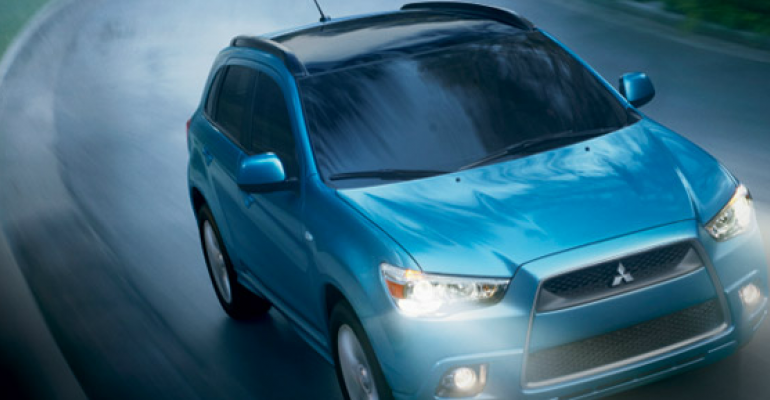Share gains by Kia, Hyundai, Mitsubishi and Nissan weren’t enough to offset losses at Honda, Infiniti, Toyota and Subaru, as Asian auto makers saw their claim on the U.S. market erode for a second consecutive year.
Asian auto makers captured 43.9% of U.S. light-vehicle sales in 2011, down from 46.5% in 2010, according to WardsAuto data.
Domestic auto makers were the biggest beneficiaries, raising their stake to 46.9% from prior-year’s 45.0%.
European OEMs grew their share to 9.2% in 2011 from 8.5% in 2010.
Kia surged on solid demand for nearly all of its model lines, especially the Sorento midsize cross/utility vehicle and Soul compact car. Each model accounted for more than 100,000 deliveries as Kia grew its U.S. market share by 0.7 points to 3.8% compared with 2010, the largest increase of any Asia-based company.
Two brands, Nissan and Kia’s sister Hyundai, saw market share climbs of 0.4 percentage points last year. Hyundai sold 5.1% of all light vehicles in the U.S. in 2011, while Nissan controlled 7.4% of the market.
Hyundai’s 645,691 deliveries marked the brand’s all-time high. Its Sonata midsize sedan, with 225,961 units, ranked 7th among 2011’s best-selling passenger cars. Nissan’s Altima was No.2 in car sales with 268,981 sales.
Nissan’s Versa subcompact held onto the title of best-selling subcompact car with 99,730 units. Nissan’s Leaf electric vehicle tallied 9,674, outpacing by some 2,000 units General Motors’ Chevrolet Volt range-extended EV.
Mitsubishi, the biggest gaining U.S. brand in 2011 in terms of sales percentage with a 41.9% jump, saw its U.S. market share inch up to 0.6% from 0.5% in 2010.
The new Outlander Sport CUV, launched early last year, was Mitsubishi’s best-selling model, racking up 16,443 deliveries. The soon-to-be-discontinued Galant midsize sedan was runner-up with 15,631.
The brand’s new “I” electric vehicle, on sale since November, tallied a modest 80 units in 2011.
Mazda’s sales grew, but its full-year market share held steady at 2.0%.
The Mazda3 compact again was the auto maker’s biggest seller, although sales dipped 3.7%. The new Mazda2 subcompact tallied a modest 13,952 units, making it the segment’s second-worst performer after Scion’s xD.
Suzuki, with only 26,619 units sold in the year, realized a 10.9% jump from 2010’s results. The brand also kept its share of the U.S. market, ending 2011 at 0.2%.
The year was dismal for Honda and Toyota with well-documented woes. Both major auto makers were hobbled more than fellow Japan-market Big-Three player, Nissan, following Japan’s earthquake and tsunami.
Toyota, including its Scion and Lexus brands, ended the year with a 12.9% U.S. light-vehicle share, down from 15.3% in 2010. With each passing month in 2011, Toyota, Scion and Lexus brand models fell below year-ago in sales, as inventories tightened dramatically due to parts shortages emanating from Japan.
However, Toyota managed to keep enough deliveries of its midsize Camry flowing to dealers to continue the model’s decade-long stint as the No.1 selling passenger car in the U.S.
Toyota also squeaked out a win in the minivan segment, with the Sienna reigning over the Dodge Caravan.
Notably off from 2010 were all Toyota and Lexus hybrids, although the new Lexus CT 200h compact added 14,381 sales, exceeding its 12,000-unit annual target.
The Prius, whose lineup now includes the new Prius V wagon, lost sales and share in 2011. Nevertheless the car remained dominant, as 48.6% of all alternative-powertrain vehicles sold in the U.S. last year in 2011 bore the Prius badge.
Honda, whose total U.S. market share including Acura fell to 9.0% from 10.6% in 2010, saw similar across-the-board declines, with the top-selling Accord and Civic taking a beating. The Accord lost at least 40,000 sales from 2010 and the Civic at least 30,000 of its year-ago volume.
An American Honda official told WardsAuto in October unexpected consolidation among the auto maker’s parts suppliers was to blame for its post-earthquake production woes.
Honda’s CR-V succumbed to the Ford Escape in the race for best-selling CUV.
Honda’s Acura brand lost 0.2 percentage points of share, with all models, save for the slow-selling RDX, up 1.5%, down year-on-year.
Also losing share was Nissan’s Infiniti brand, which blamed fallout from the earthquake for its 2011 drop-off. Infiniti held 0.8% of the U.S. market in 2011, down from 0.9% in 2010.
The G sedan and coupe again was Infiniti’s No.1-selling model but was flat, with sales inching up 0.2%.
One of Infiniti’s newest models, the M mid-large sedan, saw sales tumble 26.0%.
Subaru, one of the fastest-growing brands in recent years, saw the earthquake impact its U.S. sales, which rose 1.2% from 2010 but fell 44,000 units shy of the targeted 300,000-unit mark.
Subaru’s U.S. share dipped to 2.1%, from 2.3% in 2010.





